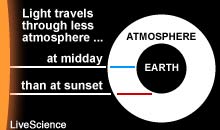Blue Skies Only In the Eye of the Beholder

The sky is blue -- physicists tell us -- because blue light in the Sun's rays bends more than red light. But this extra bending, or scattering, applies just as much to violet light, so it is reasonable to ask why the sky isn't purple.
The answer, explained fully for the first time in a new scientific paper, is in the eye of the beholder.
"The traditional way that people teach this subject is that sunlight is scattered -- more so for shorter wavelengths than for longer ones," says Glenn Smith, an engineering professor at Georgia Tech. "The other half of the explanation is usually left out: how your eye perceives this spectrum."
While writing a physics textbook some years ago, Smith noticed that physiology usually gets short shrift, even though the spectrum of sky light -- when analyzed -- is about equal parts violet and blue.
Smith has written an article for the July issue of the American Journal of Physics that puts the physics of light together with the physiology of human vision.
"This is nothing that people who work with eyes haven't known for a long time," Smith told LiveScience. "I just had not seen it all in one place before."
The physical explanation for the blueness of the sky is attributed to the work of Lord Rayleigh in the 19th Century.
Get the world’s most fascinating discoveries delivered straight to your inbox.
As a common prism reveals, sunlight is made of all the colors of the rainbow. When light from the Sun enters Earth's atmosphere, it is scattered, or deflected, by molecules in the atmosphere -- primarily nitrogen and oxygen.
Shorter wavelengths (blue and violet) are scattered more than longer wavelengths (red and yellow). So as we look in a direction of the sky away from the Sun, we see those wavelengths that are bent the most.
The light of day is actually a complex spectrum of many different wavelengths, but it is dominated by light with wavelengths between 400 nanometers (violet) and 450 nanometers (blue). A nanometer is one billionth of a meter.
The human eye is sensitive to light between roughly 380 and 740 nanometers. On a typical retina, there are 10 million rods for sensing low light levels and 5 million cones for detecting color.
Each cone contains pigments that restrict the range of wavelengths that the cone responds to. There are three varieties of cones for long, medium and short wavelengths.
"You need all three of them to see color correctly," Smith explained.
The peak response for the long cones is at 570 nanometers (yellow), medium at 543 nanometers (green), and short at 442 nanometers (between violet and blue). But the three cones are sensitive over broad, overlapping wavelength ranges, which means two different spectra can cause the same response in a set of various cones.
A good example of this is yellow. There is a certain narrow range of wavelengths that we might call "pure" yellow (or another for "pure" blue, and so on). However, the same set of cones that reacts to a light of pure yellow also responds to the superposition of pure red and pure green light.
Two spectra that have the same cone response are called metamers. Smith stressed that this only concerns the neural signal coming out of the eye -- long before any processing by the brain.
"In previous research, people excised cones from the eyes of dead people and measured the response to different spectra," he said.
The same "trick" that makes red and green turn into yellow is happening in the sky. But in this case, the sky's combination of violet and blue elicits the same cone response as pure blue plus white light, which is an equal mixture of all the colors.
"Your eye can't tell the difference between that complex spectrum and one that is a mixture of pure blue and white," Smith said.
In other animals, the sky color is undoubtedly different. Outside of humans and some other primates, most animals have only two types of cones instead of three (dichromatic vs. trichromatic).
Honeybees and some birds see at ultraviolet wavelengths that are invisible to humans.
- The New Mystery of Water
- Rare but Real: People Who Feel, Taste and Hear Color
- Advanced Optics ... on Butterfly Wings
- The Many Flavors of Fog
Blue Sky, Red Sunset
Image Galleries







